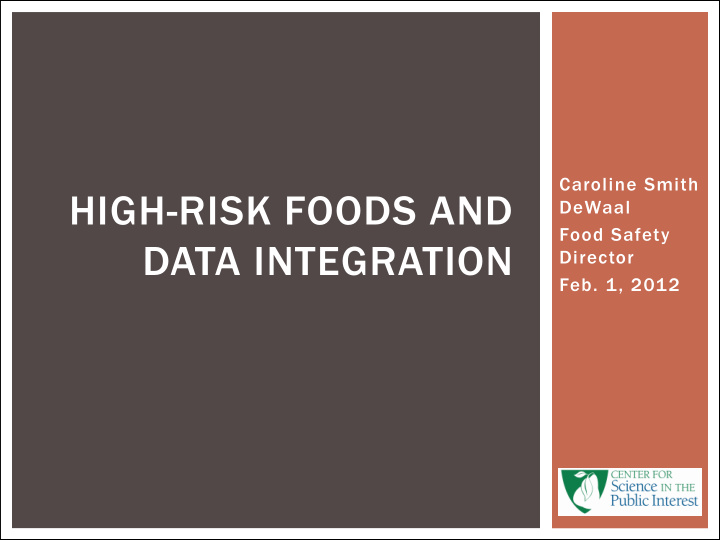



Caroline Smith HIGH-RISK FOODS AND DeWaal Food Safety DATA INTEGRATION Director Feb. 1, 2012
CSPI: FOUR DECADES OF CONSUMER ADVOCACY Bi-national consumer advocacy organization founded in 1971 by Michael Jacobson, Ph.D. Focuses on nutrition and health, and food safety Publishes award-winning Nutrition Action Healthletter Represents over 900,000 subscriber/members in the United States and Canada 2
OVERVIEW World Health Organization/AGISAR Surveillance Model U.S. Data Sources Utility of Outbreak Data Linking Salmonella serotype data in food to human illness What existing data sets tell us Is it predictive, either long-term or short-term? 3
WHO MODEL The WHO model for surveillance looks at pathogens at three points in the food chain. Pathogens in the animal population Broilers, Turkeys Pathogens in the retail meat sector Ground meat, retail samples Public health (outbreaks/cases) Cases linked to outbreaks/FoodNet cases 4
U.S. DATA SOURCES FSIS PR/HACCP testing Broilers, ground chicken, turkey, ground turkey FDA NARMS retail testing Chicken breast, ground turkey CDC FoodNet 15% of U.S. population under active surveillance, captures cases of foodborne illness CSPI Outbreak Alert 5
CSPI’S OUTBREAK ALERT! Over 6,800 outbreaks between 1990-2009 Using CDC’s Foodborne Outbreak Online Database (FOOD), CSPI maintains a database of those foodborne illness outbreaks with an identified etiology and food vehicle. Outbreaks in the CSPI database are indexed into one of thirteen food categories. Each category is then subdivided into food types. 6
FOOD CATEGORIES IN OUTBREAK ALERT! FDA-Regulated Food USDA-Regulated Food Beverages Beef Breads & Bakery Pork Dairy Poultry Eggs & Egg Dishes Luncheon & Other Meats Game Multi-Ingredient Foods (No-Meat) Produce Both Seafood 7
METHODOLOGY Analyzed 3 years of data, 2006-2008 FSIS PR/HACCP testing – Lists top 10 serotypes for each year Looked at serotypes of public health import (excluded S. Kentucky) FDA NARMS retail testing – looked at overall Salmonella prevalence data CDC FoodNet – Lists top 20 serotypes for each year, does not include food attribution 8
POULTRY OUTBREAKS IN THE U.S. 9
FOODNET DATA 2006-2008 Note: FoodNet data has no food attribution 10
SALMONELLA IN CHICKEN 2006-2008 Note: FoodNet data has no food attribution 11
SALMONELLA IN TURKEY 2006-2008 Note: FoodNet data has no food attribution 12
SALMONELLA SEROTYPES IN CHICKEN 2006 Note: FoodNet data has no food attribution 13
SALMONELLA SEROTYPES IN CHICKEN 2007 Note: FoodNet data has no food attribution 14
SALMONELLA SEROTYPES IN CHICKEN 2008 Note: FoodNet data has no food attribution 15
CONCLUSIONS - CHICKEN Dominant serotypes in chicken samples are S. S. Enteritidis, S. Heidelberg Serotype most dominant in chicken at retail is S. S. Typhimurium, S. Heidelberg The dominant strain causing human illnesses (captured in the FoodNet data) are S. Enteritidis, S. Typhimurium 16
SALMONELLA IN TURKEY 2006-2008 Note: FoodNet data has no food attribution 17
SALMONELLA SEROTYPES IN TURKEY 2006 Note: FoodNet data has no food attribution 18
SALMONELLA SEROTYPES IN TURKEY 2007 Note: FoodNet data has no food attribution 19
SALMONELLA SEROTYPES IN TURKEY 2008 Note: FoodNet data has no food attribution 20
CONCLUSIONS - TURKEY The dominant serotype in turkey samples is S. S. Hadar The serotypes most dominant in turkey at retail are S . Hadar, S. Heidelberg The dominant serotypes causing human illnesses (captured in the FoodNet data) are S. Enteritidis, S. Typhimurium 21
A CAUTIONARY NOTE: RECENT ANTIBIOTIC-RESISTANT SALMONELLA OUTBREAKS 2011 Multi-state outbreak of S. Heidelberg in ground turkey – ABR resistant 2011 Multi-state outbreak of S. Hadar in ground turkey – ABR resistant Other ABR outbreaks of interest 2011 Multi-state outbreak of S. Typhimurium in ground beef – ABR resistant 2009 Two multi-state outbreaks of S. Newport in ground beef – ABR resistant 2009 Multi-state outbreak of S. Typhimurium in ground beef – ABR resistant 22
INCORPORATING FOOD TESTING DATA INTO FUTURE ANALYSIS FDA is receiving new food testing data from industry as a result of recent legislation The Reportable Food Registry requires companies to report food contamination events to FDA when food has been released to the public FSMA requires laboratories to report certain food testing data to FDA FDA needs to develop a method of capturing this data and applying it as appropriate to anticipate existing and emerging hazards. IFSAC should consider methods to incorporate new sources of food testing data into its analysis 23
Thank you! Caroline Smith DeWaal Food Safety Director Center for Science in the Public Interest 1220 L St., NW Suite 300 Washington, DC 20005 Phone: (202) 777-8364 Fax: (202) 265-4954 E-mail: cdewaal@cspinet.org On the internet: www.cspinet.org and www.safefoodinternational.org 24
Recommend
More recommend